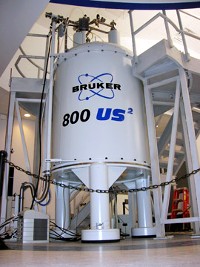Scientists at Rensselaer Polytechnic Institute in Troy, New York, are using nuclear magnetic resonance to understand and improve the process of purifying drugs that use proteins, which are notoriously difficult to separate from other potentially deadly impurities.
A team led by Steven Cramer, professor of polymer engineering at Rensselaer studied the process of multimodal chromatography which has generated interest in the pharmaceutical industry for its ability to separate proteins from their surrounding materials, such as DNA and other proteins. Cramer and his colleagues published their findings in the 2 September online early edition of the journal Proceedings of the National Academy of Sciences (paid subscription required). National Science Foundation funded the research.
The process works by encouraging the desired protein to stick to a material that contains a ligand, a type of molecular glue. The more selective the ligand is at binding to a specific protein, the more efficient the process is, and the less additional steps are required to produce the final drug. This property results in reduced costs for the production of the drug. But despite its widespread use and benefits, there is very little understood about how the process actually works or how the ligands can be improved.
Cramer and his colleagues grew several mutants of a protein called ubiquitin, and collected these variations in a protein library. They then ran the protein library through traditional ion-exchange and more sophisticated multimodal chromatography. They found little to no difference in the binding of proteins to ligands in the traditional ion exchange system, but large fluctuations in the binding of some of the different mutants in the multimodal system.
To better understand what was happening, Cramer and colleagues tested the ubiquitin and multimodal ligands with Rensselaer’s nuclear magnetic resonance (NMR) spectrometer, which uses magnetic properties in organic materials to provide information on the minute molecular chemical properties of those materials (pictured top left).
With NMR, they were able to determine what part and type of the protein the ligands were binding to and how strongly they would bind. Their results validated the previous multimodal chromatography data, showing that each of the protein mutants that strongly fluctuated in their binding strength in the multimodal chromatographic system were also the same ones identified with NMR.
“We hope to use our insights to help those in the industry develop improved processes to provide much less expensive drugs and dramatically reduce healthcare costs,” says Cramer.


 RSS - Posts
RSS - Posts
This is certainly one of the better articles I have located on this subject. I would like to know if you have you looked into the opposite side of the argument of natural health? Personally, I think a solid case could be made either way, but please let me know if you have found more sources on the Web that back up what you are saying.